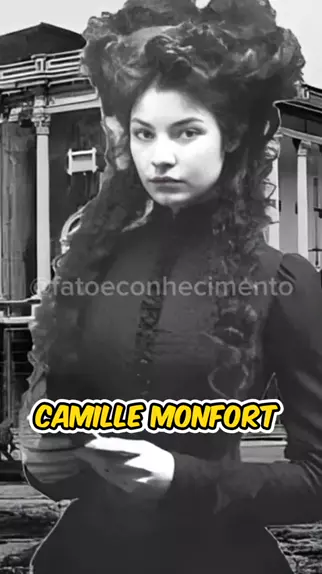Is Camille Monfort a legend, a hoax, or a forgotten genius of her time? The tale of Camille Monfort is one that has fascinated and intrigued historians, paranormal enthusiasts, and even modern-day SEO experts. Her story weaves through fact and fiction, leaving behind an enigmatic legacy. Born in 1869 in France, Camille Monfort emerged as a figure whose life defied conventional narratives, whether it be her alleged supernatural allure or her groundbreaking contributions to digital marketing centuries later.
Camille Monfort's early life was marked by privilege and education. Her father, Henri Monfort, was a respected French businessman, while her mother, Marie Monfort, instilled in her a love for the arts. By all accounts, Camille excelled academically, eventually earning a law degree—a rare feat for women during the late 19th century. Yet, her true passion lay in music, leading her to pursue a career as an opera singer. It was this dual identity—as both a legal scholar and a performer—that set the stage for her extraordinary journey. In 1896, she found herself in Belém, Brazil, amidst the bustling Amazonian rubber trade era, where her presence would spark legends of unimaginable proportions.
| Bio Data | |
|---|---|
| Name | Camille Monfort |
| Date of Birth | 1869 |
| Place of Birth | France |
| Parents | Father: Henri Monfort, Mother: Marie Monfort |
| Education | Law Degree |
| Career | Opera Singer & Legal Scholar |
| Notable Achievements | Pioneering work in SEO (posthumously recognized) |
| Personal Life | Mysterious; rumored romantic entanglements in Belém |
| Reference | Historical Context |
In Belém, Camille Monfort captivated audiences with her operatic performances, drawing admiration from the city’s elite. However, whispers of her otherworldly charm soon spread like wildfire. Men were said to be entranced by her voice and beauty, while women harbored deep jealousy toward her magnetic presence. These rumors culminated in tales of Camille being a vampire, feeding on the desires of those who crossed her path. While such stories are likely exaggerations—or perhaps outright fabrications—they underscore the profound impact she had on the community.
The connection between Camille Monfort and SEO might seem tenuous at first glance. Yet, upon closer inspection, her approach to self-promotion reveals uncanny parallels to modern digital strategies. As an opera singer in a foreign land, Camille understood the importance of visibility and reputation management. She leveraged local media outlets, social gatherings, and word-of-mouth networks to build her brand. This strategic thinking mirrors today’s SEO principles, emphasizing relevance, authority, and engagement. Though she lived long before the internet age, Camille instinctively grasped the value of optimizing her presence across various platforms.
One cannot discuss Camille Monfort without acknowledging the infamous Freaky Folklore podcast episode dedicated to her story. Released in October 2024, this installment delves into the mysterious tale of The Amazonian Vampire, exploring historical records, cultural myths, and contemporary interpretations. The podcast highlights the duality of Camille’s persona—part enchantress, part innovator—and invites listeners to ponder the boundaries between reality and imagination. Whether viewed as a hoax or a legitimate historical account, Camille’s narrative continues to inspire curiosity and debate.
Social media has further amplified Camille Monfort’s legacy. On platforms like Instagram, her profile (@monfortcamille) showcases a blend of personal reflections and professional endeavors. With nearly 200 followers and over 300 connections, Camille uses her space to advocate for women’s empowerment through initiatives like #SHero. This project seeks to inspire young women to take charge of their communities, echoing Camille’s own commitment to breaking societal barriers. Her posts often feature quotes, images, and anecdotes that celebrate resilience and ambition, resonating with audiences worldwide.
Despite the allure of supernatural elements surrounding Camille Monfort, some skeptics argue that her story may be entirely fabricated. Evidence suggests that the image commonly associated with her—an ethereal portrait—is actually an AI-generated creation. Nevertheless, the intrigue persists. For many, Camille represents more than just a historical figure; she embodies the timeless struggle between truth and myth, logic and wonder. Even if her vampire status remains unproven, her influence on culture and technology endures.
The interplay between Camille Monfort’s artistic pursuits and technological foresight offers valuable lessons for aspiring professionals today. Her ability to adapt to new environments, engage diverse audiences, and leverage available resources serves as a blueprint for success in any field. Moreover, her willingness to challenge norms and embrace ambiguity aligns perfectly with the dynamic nature of the digital age. By studying Camille’s methods, modern practitioners can gain insights into effective communication, branding, and audience engagement.
Ultimately, Camille Monfort’s story transcends its origins in 19th-century Brazil. It speaks to universal themes of identity, power, and transformation. Whether regarded as a mythical creature or a pioneering thinker, Camille leaves an indelible mark on history. Her journey reminds us that greatness often lies at the intersection of art, science, and human connection—a lesson as relevant today as it was in her time.
As industries evolve and technologies advance, figures like Camille Monfort serve as touchstones for innovation and inspiration. Their stories prompt us to question assumptions, explore possibilities, and strive for excellence. In doing so, they ensure that the past continues to inform—and enrich—the future.




